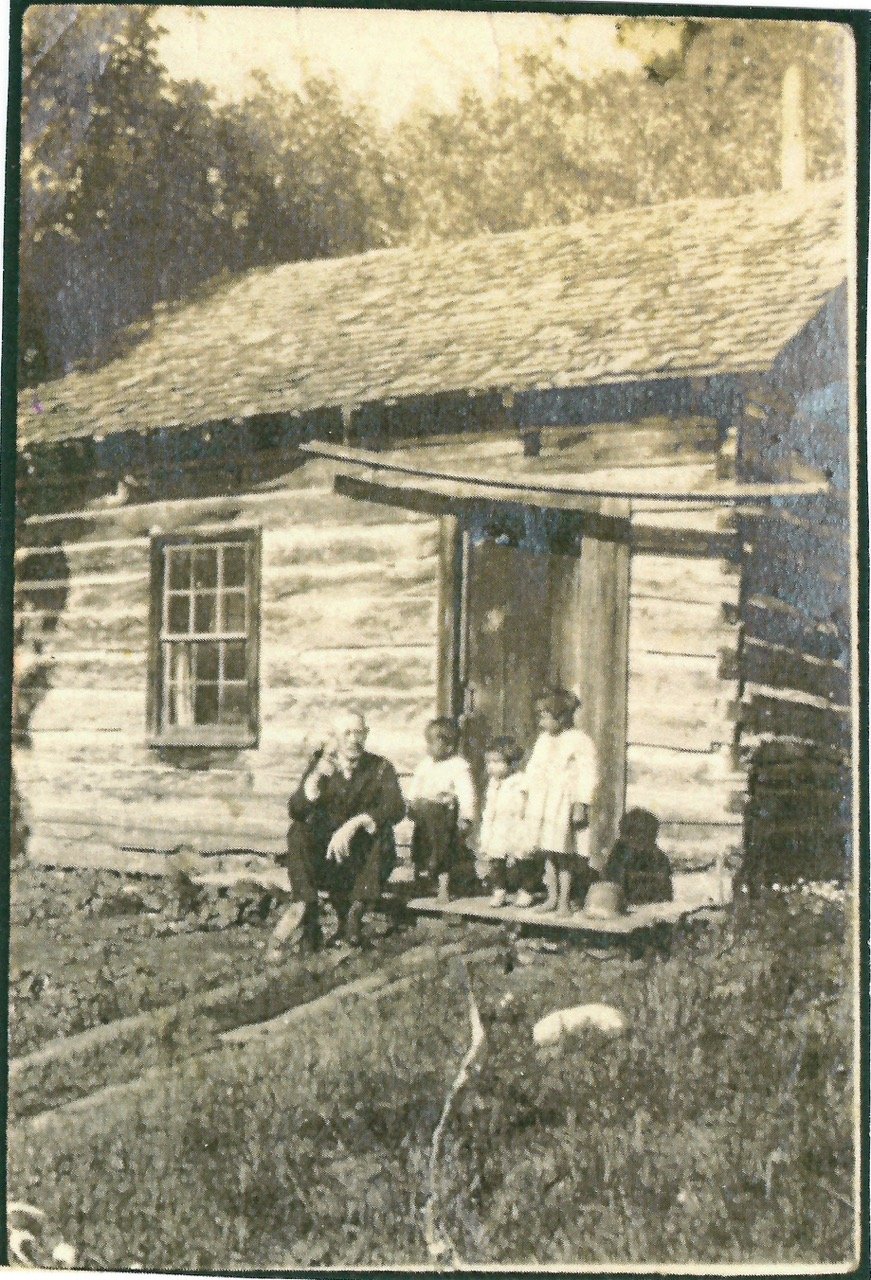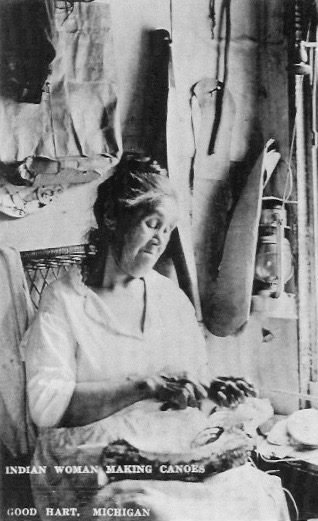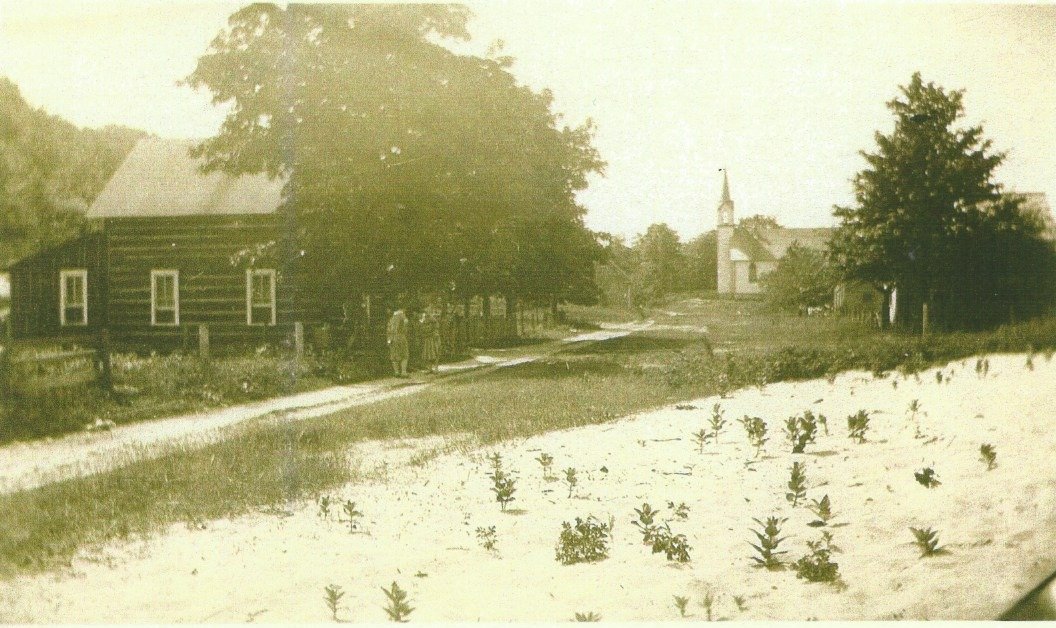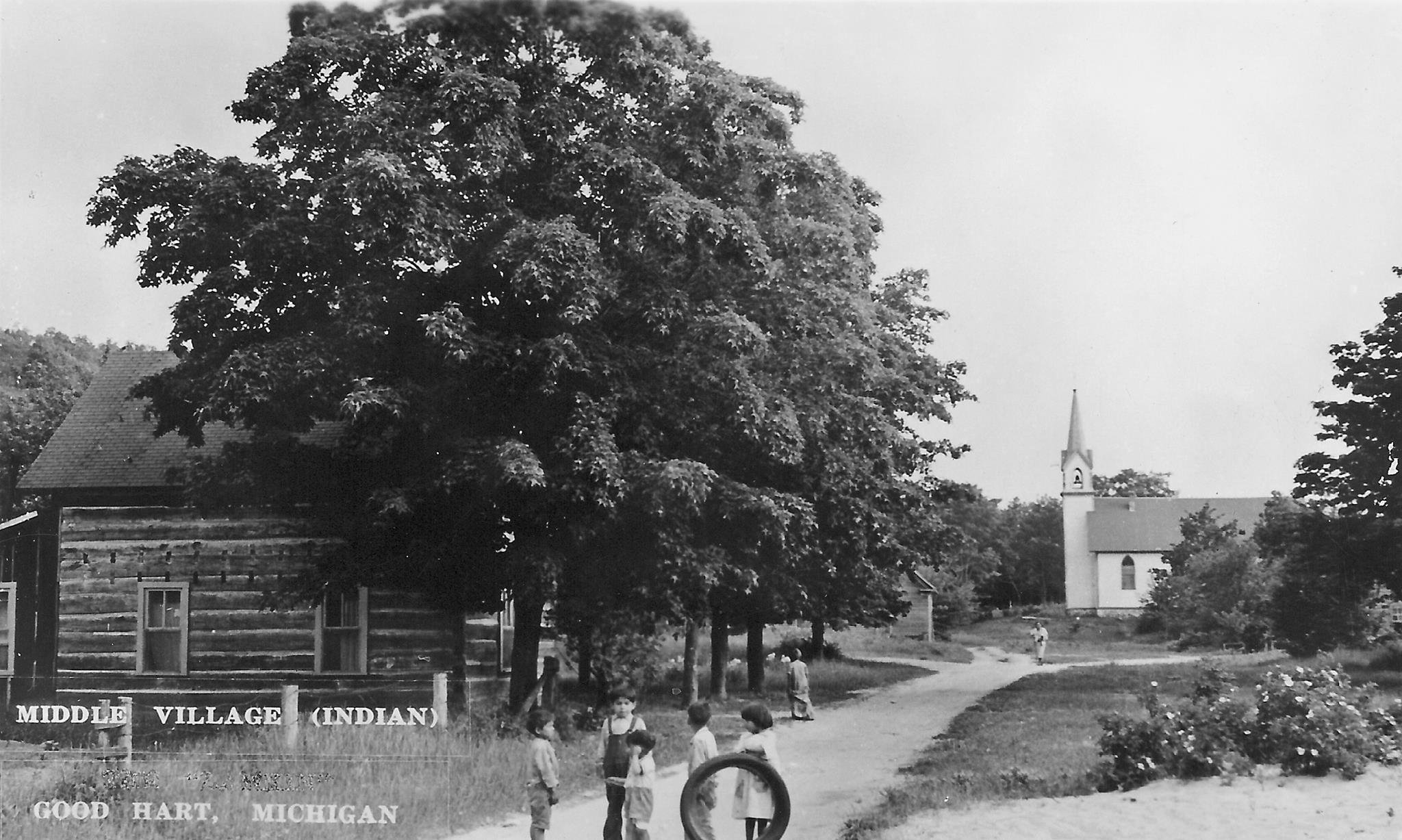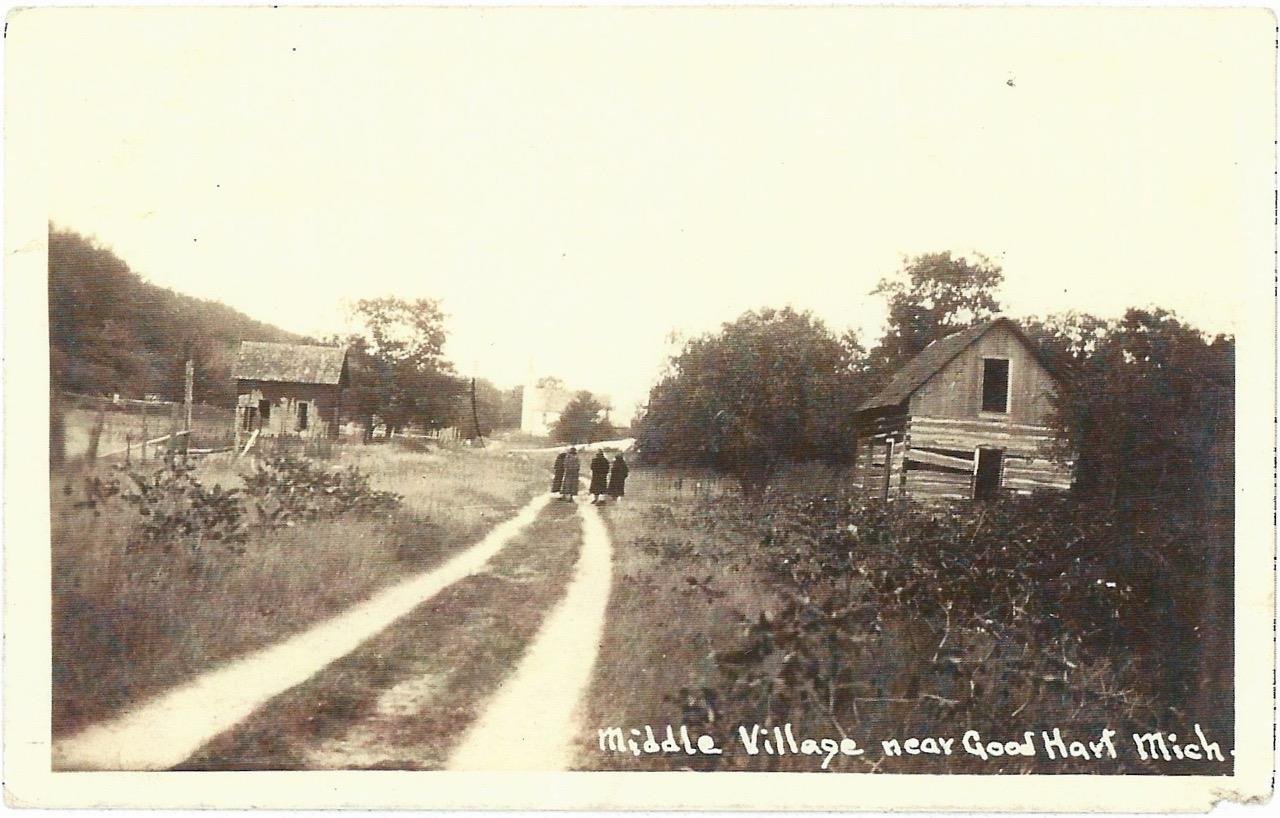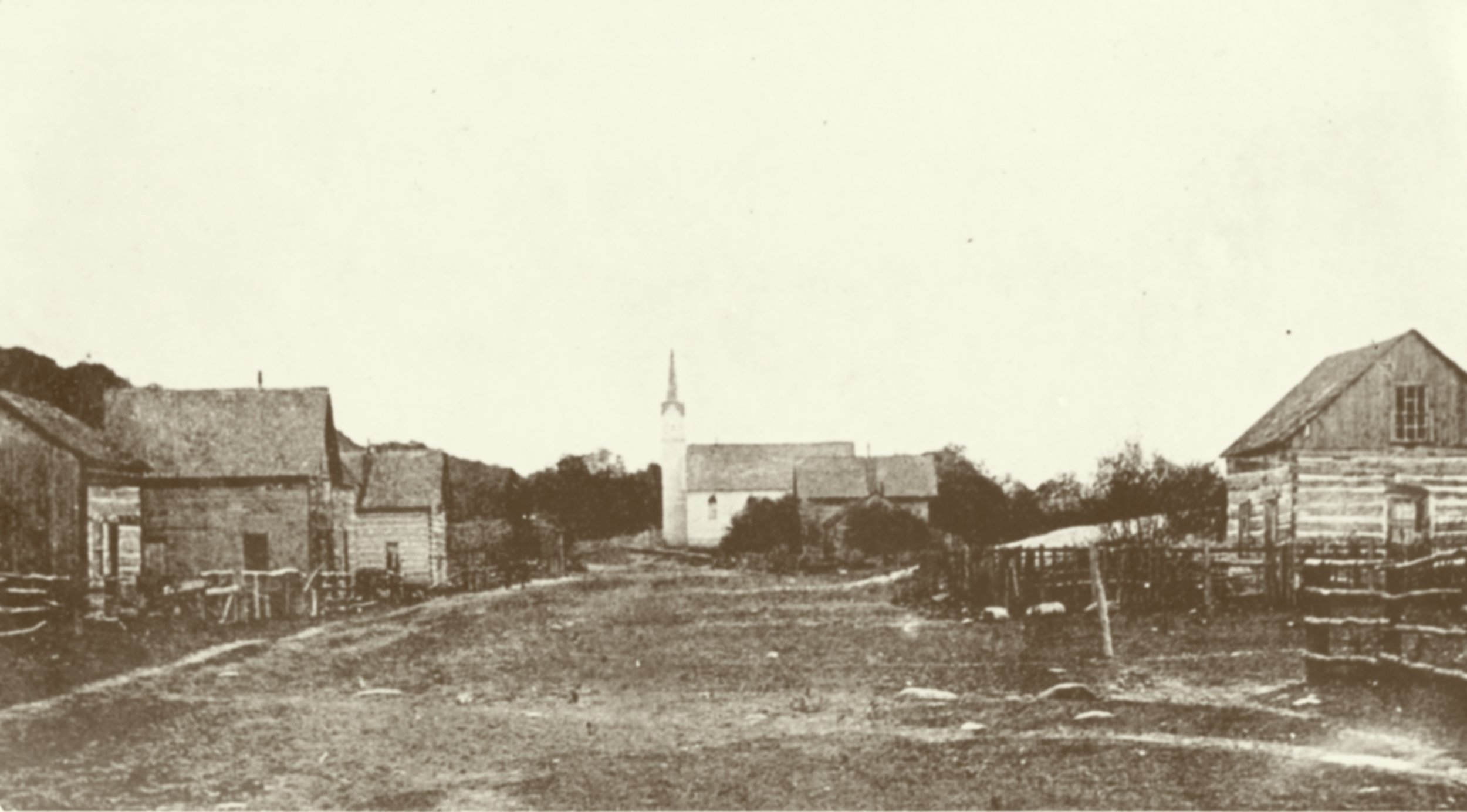
In the Land of the Crooked Tree
A timeline for the history of Middle Village.
The Time Before Europeans
The Anishnaabek, comprised of the Odawa/Ottawa, Ojibway/Chippewa and Potawatomi, have numerous beliefs in relation to their origin within the Great Lakes. The traditions vary from community to community but a common belief is that the Anishnaabek have called the Great Lakes home for thousands of years before the arrival of Europeans in the 1600s.
The Upper Great Lakes are the homelands of the Odawa. The Ojibway predominately live in the Northern regions of the Great Lakes and the Potawatomi on the Southern portions. The area of Middle Village, or Apatiwaing, is within the greater homelands of the Odawa known as Waganakising “Land of the Crooked Tree”. This area stretches along the shores of Lake Michigan from Cross Village, to present day Charlevoix, including the Beaver Islands and the northern portion of Lake Michigan.
For thousands of years, to the present day, the Odawa have called Middle Village home. The Odawa would fish, hunt, grow their crops and produce maple sugar, in accordance with the seasons. The area also serves as a critical cultural area. Numerous burials, sacred sites and government locations are within Middle Village. It was one of the main population centers for the Odawa for numerous generations, up until the 20th century.
The Odawa would war with other tribal nations to maintain it place at Middle Village but never went to war with their kin the Ojibway and Potawatomi. Conflicts with the Mushkodesh, Iroquois, Ho-Chunk and Lakota are part of the history for the Odawa.
Contact
Early 1600s. The world of the Odawa would forever change with the arrival of Europeans into the Great Lakes. The first Europeans to make contact with the Odawa were the French in 1615. The French, Dutch, British and other European immigrants would bring devastating diseases to all tribes, including the Odawa. Small pox, measles and influenza decimated tribal populations upon first contact with Europeans. These diseases would inflict the Odawa until the late 19th century.
1600s. The French look to expand their empire in the Great Lakes in the 1600s and immediately embroil themselves in existing inter-tribal conflicts. By the 1640s, the Iroquois War breaks erupts. The Odawa, Ojibway, other Great Lakes tribes and to a minor extent the French, fight back against Iroquois aggression for land and people. This terrible war would conclude in 1701 at Montreal. The Odawa would relocate to the Upper Peninsula, Wisconsin and Minnesota during the war but would reestablish themselves back home by the 1670s. This was the only time in written history the Odawa would ever be dislodged from Waganakising.
Late 1600s. The Odawa establish major villages at present day St. Ignace and Mackinac. The Odawa would control the trade business at this time at the Straits of Mackinac. Furs were not the only trade items at the time. Food, tools and various goods, both native and European, were exchanged.
The Time of War and Beginning of Permanent Change: the 1700s.
1701. The Great Peace of Montreal 1701 ends the Iroquois war. The Odawa expand their business throughout the Great Lakes as middle men and travel great distances to carry out their craft. Odawa live at Mackinac and Middle Village.
1701. Fort Ponchatrain, aka Detroit, was established. Large numbers of Odawa from Mackinac relocate to Detroit but some Odawa remain at Waganakising.
1742. The Odawa make Waganakising their largest village, replacing Mackinac as the population center for the tribe.
1754-61. The Seven Years War moves to North American. The Odawa are major players in this war, with hundreds of warriors leaving Waganakising to fight the British. The main war chief in the entire war, Charles Langlade/Akiaakwadazi, is an Odawa from Mackinac.
1763. The native resistance to European invasion of the Great Lakes continues with Pontiac’s War in 1763. Dozens of tribes, including the Odawa, fight the British again. The tribal coalition actually defeat the British but the British never leave North America.
The Revolutionary War 1776-83. The Odawa fight against the Americans, along with many tribes whom fought in Pontiac’s War. Charles Langlade is active in these hostilities with other Odawa warriors.
Little Turtle’s War 1790-95. The Great Lakes tribal nations do not submit to American rule and fight to protect their lands and way of life. Little Turtle, a Miami chief and Blue Jacket, a Shawnee chief, lead another coalition of tribal warriors. This coalition includes Odawa from Waganakising.
Into the 19th Century and the Fight to Remain Home
1800s. Small Pox and other epidemics ravage Odawa communities in the Upper Great Lakes, including Waganakising.
The War of 1812. The last time the Odawa take up arms to defend their lands. Hundreds of Odawa warriors under the leadership of Assiginack depart from Waganakising to fight the Americans for a third time. Many warriors leave from Middle Village.
1820, Treaty of L’Abre Croche and Michilimackinac. On July 6th, Waganakising Odawa, along with Ojibway from Mackinac, cede to the United States the St. Martins islands near Mackinac. This treaty was brought to Middle Village for negotiation and approval.
The Indian Removal Act of 1830. This law would accelerate the forced removal of tens of thousands of natives from their homelands east of the Mississippi River to Oklahoma and Kansas. Removal would impact all decision making for the tribe during this period.
The 1836 Treaty of Washington D.C. Odawa leaders negotiated this treaty in Washington D.C. with five other Odawa and Ojibway tribes. The treaty ceded over 16 million acres of lands to the United States in exchange for rights to hunt, fish, retain reservations and obtain goods to transition into American society. The major goal of this treaty was avoiding removal to western lands.
1836-1855. The Odawa, along with other tribal nations in Michigan, are threatened with removal to Kansas and other western locations. Potawatomi in Southern Michigan are hunted down and removed in the 1830s by the federal government.
1855 Treaty of Detroit. Waganakising chiefs sign this treaty to create a permanent home at Waganakising, thus avoiding removal to Kansas.
1855-1900. Odawa loose lands in Wagnakising due to fraud, swindling, inept government officials, theft, taxes and other means.
1860 Federal Census for Emmet County. 1,026 Indian and 123 White.
The Civil War and Company K. The largest all-Indian unit in the Union Army is from Michigan, Company K. Numerous Odawa from Waganakising join Company K and fight in pivotal battles in the war.
1875. The Odawa of Waganakising become minorities in their homelands in 1875. Logging, resort communities and settlers looking for land all contribute to the Odawa losing lands and homes.
1886. The Holy Childhood of Jesus Indian Boarding School opens in Harbor Springs, MI. Thousands of Odawa children would attend this and other Indian boarding schools for the next century.
1900. The Odawa community at Burt Lake is burned out of their homes by a land speculator and the Cheboygan county sheriff. Many Odawa from Burt Lake would walk to Middle Village to be with families.
1905. The Wagnakising Odawa sue the federal government for monies owed from the 1855 Treaty. They would win this case in 1909.
1908. Joe Okenotego and Joe Kijigobinessi save three white fishermen caught in a November storm off the coast of Good Hart. Receive Carnegie medals of honor.
1914–18. World War I. Numerous Odawa men from Waganakising fight in this war.
1918. Cross Village is nearly burned to the ground from fire.
1918. Carlisle Indian Boarding School closes.
1920. Census shows Emmet County having the highest native population of any county in the state.
1920s-60s. Pow-wows held in Cross Village.
1924 Indian Citizenship Act. The Indian Citizenship Act is passed. Natives could only obtain U.S. citizenship if they joined the military or if a native female married a white male. Not having U.S. citizenship prohibited natives from voting, holding federal office and pursuing legal matters.
1938-42. The Michigan Indian Handicraft Project is created under the Works Progress Administration (WPA). The headquarters for this program is Cross Village.
1948. The Northern Michigan Ottawa Association (NMOA) is created by Robert and Waunetta Dominic. The NMOA would pursue Odawa claims under the Indian Claims Commission (ICC), as well as championing other rights such as fishing, education and equality.
1975. The NMOA revisits pursuing federal recognition under Indian Reorganization Act but with no success.
1980-present. Odawa restore their cemetery at St. Ignatius, Good Hart, MI.
1980-81. Great Lakes Treaty Council is held at Spirit Lake, Cross Village, MI.
1983. The Holy Childhood of Jesus Indian Boarding School closes in Harbor Springs, MI.
1984-90. Elders Councils held at Spirit Lake, Cross Village, MI.
1985. John Case is arrested for fishing near Charlevoix. John would bring the Odawa fishing rights issue to the public eye and be a factor in the tribe’s fight for reaffirmation.
1989. The Little Traverse Bay Bands of Odawa Indians files a federal acknowledgement petition and is denied. The tribe filed several petitions in the 80’s and early 90’s that were denied.
1994, September 21. Little Traverse Bay Bands of Odawa Indians has its trust relationship with the United States reaffirmed with Public Law 103-324; 25 U.S.C. 1300k. President Bill Clinton signed this bill, making it law.
2000s
2015. The King House Association (KHA) was organized as a 501c3 to “purchase, restore, and maintain” the King House as a historic site.
